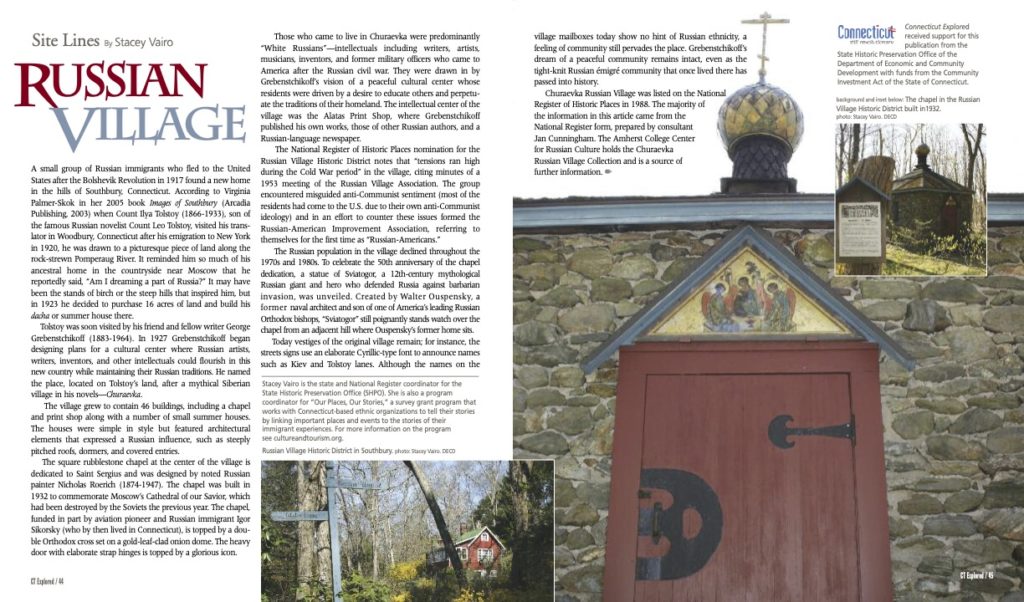
bottom left: Russian Village Historic District in Southbury. photo: Stacey Vairo. background and inset right: The chapel in the Russian Village Historic District built in1932. photo: Stacey Vairo. DECD
By Stacey Vairo
(c) Connecticut Explored Inc. Fall 2013
Subscribe/Buy the Issue!
A small group of Russian immigrants who fled to the United States after the Bolshevik Revolution in 1917 found a new home in the hills of Southbury, Connecticut. According to Virginia Palmer-Skok in her 2005 book Images of Southbury(Arcadia Publishing, 2003 when Count Ilya Tolstoy (1866-1933), son of the famous Russian novelist Count Leo Tolstoy, visited his translator in Woodbury, Connecticut after his emigration to New York in 1920, he was drawn to a picturesque piece of land along the rock-strewn Pomperaug River. It reminded him so much of his ancestral home in the countryside near Moscow that he reportedly said, “Am I dreaming a part of Russia?” It may have been the stands of birch or the steep hills, but in 1923 he decided to purchase 16 acres of land and build his dacha or summer house there.
Tolstoy was soon visited by his friend and fellow writer George Grebenstchikoff (1883-1964). In 1927 Grebenstchikoff began designing plans for a cultural center on the site where Russian artists, writers, inventors, and other intellectuals could flourish in this new country while maintaining their Russian traditions. He named the place after a mythical Siberian village in his novels—Churaevka.
The village grew to contain 46 buildings, including a chapel and print shop along with a number of small summer houses. The houses were simple in style but featured architectural elements that expressed a Russian influence, such as steeply pitched roofs, dormers, and covered entries.
The square rubblestone chapel at the center of the village is dedicated to Saint Sergius and was designed by noted Russian painter Nicholas Roerich (1874-1947). The chapel was built in 1932 to commemorate Moscow’s Cathedral of our Savior, which had been destroyed by the Soviets the previous year. The chapel, funded in part by aviation pioneer and Russian immigrant Igor Sikorsky (who by then lived in Connecticut), is topped by a double Orthodox cross set on a gold-leaf-clad onion dome. The heavy door with elaborate strap hinges is topped by a glorious icon.
Those who came to live in Churaevka were predominantly “White Russians”—intellectuals including writers, artists, musicians, inventors, and former military officers who came to America after the Russian Civil War. They were drawn in by Grebenstchikoff’s vision of a peaceful cultural center whose residents were driven by a desire to educate others and perpetuate the traditions of their homeland. The intellectual center of the village was the Alatas Print Shop, where Grebenstchikoff published his own works, those of other Russian authors, and a Russian-language newspaper.
The National Register of Historic Places nomination for the Russian Village Historic District notes that “tensions ran high during the Cold War period” in the village, citing minutes of a 1953 meeting of the Russian Village Association. The group encountered misguided anti-Communist sentiment (most of the residents had come to the U.S. due to their own anti-Communist ideology) and in an effort to counter these issues formed the Russian-American Improvement Association, referring to themselves for the first time as “Russian-Americans.”
The Russian population in the village declined throughout the 1970s and 1980s. To celebrate the 50th anniversary of the chapel dedication, a statue of Sviatogor, a 12th-century mythological Russian giant and hero who defended Russia against barbarian invasion, was unveiled. It was created by Walter Ouspensky, a former naval architect and son of one of America’s leading Russian Orthodox bishops. “Sviatogor” still poignantly stands watch over the chapel from an adjacent hill where Ouspensky’s former home sits.
Today vestiges of the original village remain; for instance, the streets signs use an elaborate Cyrillic-type font to announce names such as Kiev and Tolstoy lanes. Although the names on the village mailboxes today show no hint of Russian ethnicity, a feeling of community still pervades the place. Grebenscthikoff’s dream of a peaceful community remains intact, even as the tight-knit Russian émigré community that once lived there has passed into history.
Churaevka Russian Village was listed on the National Register of Historic Places in 1988. The majority of the information in this article came from the National Register form, prepared by consultant Jan Cunningham. The Amherst College Center for Russian Culture holds the Churaevka Russian Village Collection and is a source of further information.
Stacey Vairo is the State and National Register Coordinator for the State Historic Preservation Office (SHPO). She is also a program coordinator for “Our Places, Our Stories,” a survey grant program that works with Connecticut-based ethnic organizations to tell their stories by linking important places and events to the stories of their immigrant experiences. For more information on the program see cultureandtourism.org.
 Connecticut Explored received support for this publication from the State Historic Preservation Office of the Department of Economic and Community Development with funds from the Community Investment Act of the State of Connecticut.
Connecticut Explored received support for this publication from the State Historic Preservation Office of the Department of Economic and Community Development with funds from the Community Investment Act of the State of Connecticut.
Explore
Read more historic preservation stories on our TOPICS page.
